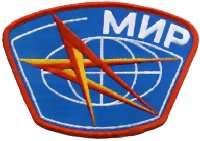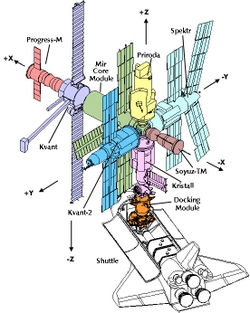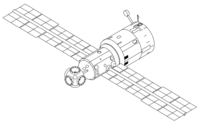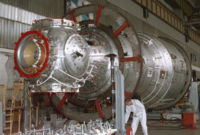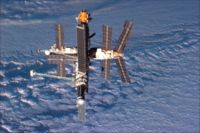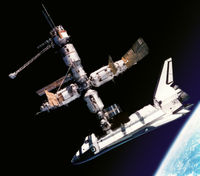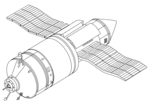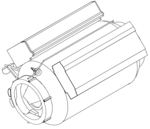Mir
2007 Schools Wikipedia Selection. Related subjects: Space transport
Mir (Russian: Мир; lit. world and/or peace) was a Soviet (and later Russian) orbital station. It was humanity's first consistently inhabited long-term research station in space. Mir currently holds the record for longest continuous human presence in space at eight days short of 10 years. Through a number of collaborations, it was made internationally accessible to cosmonauts and astronauts of many different countries. Mir was assembled in orbit by successively connecting several modules, each launched separately from February 19, 1986 to 1996.
The station existed until March 23, 2001, at which point it was deliberately de-orbited, and broke apart during atmospheric re-entry.
The manufacturer of Mir was the Khrunichev State Space Scientific Production Centre.
Development
Mir was authorized as part of the third generation of Soviet space systems in a February 17, 1976 decree to design of an improved model of the Salyut DOS-17K space station. Four Salyut space stations had already been launched since 1971. Three more would be launched during the development of Mir. At the time it was planned that the two stations ( DOS-7 and DOS-8) would be equipped with a total of four docking ports. Two at either end of the station as with the Salyut stations, and an additional two ports on either side of docking sphere at the front of the station. By August 1978 this had evolved to the final configuration of one aft port and five ports in a spherical compartment at the forward end of the station.
It was originally planned that the ports would connect to 7 tonne modules derived from the Soyuz spacecraft. These modules would have used a Soyuz propulsion module, as in Soyuz and Progress, and descent module and orbital module would have been replaced with a long laboratory module.
The Mir program was consolidated with Vladimir Chelomei's manned Almaz military space station program in a February 1979 resolution. The docking ports were reinforced to accommodate 20 tonne space station modules based on the TKS_spacecraft. NPO Energia was responsible for the overall space station, however work was subcontracted to KB Salyut due amount of on going work on Energia, Salyut 7, Soyuz-T, and Progress spacecraft . KB Salyut begin work in the summer of 1979, and drawings were released in 1982- 1983. New systems incorporated into the station included the Salyut 5B digital flight control computer and gyrodyne flywheels (taken from Almaz), and the new Kurs automatic rendezvous system, Altair satellite communications system, Elektron oxygen generators, and Vozdukh carbon dioxide scrubbers.
By early 1984 all work on Mir had ground to a halt while all resources were being put into the Buran program to get the Buran space shuttle ready for a flight testing. Funding was returned in the spring 1984 when Valentin Glushko was ordered to orbit Mir by the 27th Communist Party Congress in the spring of 1986 by the Central Committee's Secretary for Space and Defense.
It was clear that the planned processing flow could not be followed and still make the spring 1986 launch date. It was decided on Cosmonautics Day (April 12) to ship the flight model to Baikonur and conduct the systems testing and integration there. Mir arrived at the launch site on May 6, 1985. In October Mir was rolled outside of its cleanroom. The first launch attempt on February 16, 1996 was scrubbed when the spacecraft communications failed. The second attempt on February 19, 1986 at 21:28:23 UTC was successful, meeting the political deadline.
History
It was mainly serviced by Russian-manned Soyuz spacecraft and Progress cargo ships, but it was anticipated that it would also be the destination for flights by the later-abandoned Buran space shuttle. The orbiting Mir's purpose was to provide a large and habitable scientific laboratory in space.
The United States had planned to build Space Station Freedom as its counterpart to Mir, but this project was cancelled after the fall of the Soviet Union made an international cooperation possible (see International Space Station). Also, the space shuttle Challenger exploded less than a month before Mir was launched into orbit (see Space Shuttle Challenger disaster). In later years, after the end of the Cold War, the Shuttle-Mir program combined Russia's Mir capabilities with United States space shuttles and allowed American and other western astronauts to visit or stay long-term on the station. The visiting US shuttles used a modified docking collar originally designed for the Soviet Buran shuttle, mounted on a bracket originally designed for use with Space Station Freedom. With the space shuttle docked to Mir the temporary enlargements of living and working areas amounted to a complex that was the world's largest spacecraft at that time in space history, with a combined mass of 250 tons.
Inside, the 100-ton Mir looked like a cramped labyrinth, crowded with hoses, cables and scientific instruments — as well as articles of everyday life, such as photos, children's drawings, books and a guitar. It commonly housed three crewmembers, but it sometimes supported as many as six for up to a month. Except for two short periods, Mir was continuously occupied until August 1999.
Two amateur radio call signs, U1MIR and U2MIR, were assigned to Mir in the late 1980s, allowing radio operators on Earth to communicate with the cosmonauts.
A confidence trickster Peter Llewellyn almost got a ride on Mir in 1999 after promising US$100 million for the privilege.
In addition to Soviet/Russian cosmonauts, Mir hosted international scientists and U.S. astronauts.
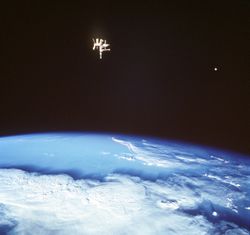
International cooperation
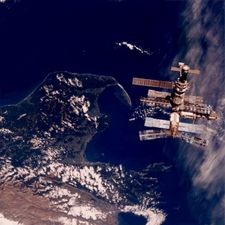
In September 1993 U.S. Vice-President Al Gore and Russian prime minister Viktor Chernomyrdin announced plans for a new space station, which would later be called the International Space Station, or ISS. They also agreed that, in preparation for this new project, the U.S. would be involved in the Mir project in the years ahead, under the code name Phase One (the ISS being Phase Two). Space shuttles would take part in the transportation of supplies and people to and from Mir. U.S. astronauts would live on Mir for many months on end, allowing the U.S. to share and learn from the unique experience that Russia had with long duration space trips.
Starting from March 1995, seven U.S. astronauts consecutively spent 28 months on Mir. During their stay several acute emergencies occurred, notably a large fire on February 23, 1997, and a collision with an unmanned Progress spacecraft on June 25, 1997. On both occasions complete evacuation was avoided by a narrow margin (there was a Soyuz escape craft for return to earth). The second disaster left a hole in the Spektr module, which was then sealed off from the rest of the station. Several space walks were needed to restore full power to Mir (one of the "space walks" was inside the Spektr module from which all the air had escaped).
The cooperation between the U.S. and Russia proved far from easy. Distrust, lack of coordination, language problems, different views of each others' responsibilities and divergent interests caused many problems. After the emergencies, the U.S. Congress and NASA considered whether the U.S. should abandon the program out of concern for astronauts' safety. NASA administrator Daniel S. Goldin decided to continue the program. In June 1998, the final U.S. Mir astronaut Andy Thomas left the station aboard the Space Shuttle Discovery.
The story of Phase One is described in great detail by Bryan Burrough in his book Dragonfly: NASA and the Crisis Aboard Mir (1998).
The Mir space station was originally planned to be followed by a Mir 2, and elements of that project, including the core module (now called ISS Zvezda) which was labeled as "Mir-2" for quite some time in the factory, are now an integral part of the International Space Station.
Final Days and Deorbit
Near the end of its life, there were plans for private interests to purchase Mir, possibly for use as the first orbital television/ movie studio. The privately funded Soyuz TM-30 mission carried two crew members, Sergei Zalyotin and Alexandr Kaleri to the station to carry out some repair work with the hope of proving that the station could be made safe; however this was to be the last manned mission to Mir. While Russia was optimistic about the future of Mir, commitments to the International Space Station project meant that there was no funding to support the aging station. Early proposals by Russia to use Mir as the core of the ISS were firmly rejected by NASA, and when the first ISS components were launched NASA insisted upon an orbit which effectively prevented transfer between the two stations. Many in the space community still felt that at least some of Mir was salvageable and that considering the extremely high costs of getting material into orbit, disposing of Mir was a wasted opportunity.
Mir's deorbit was conducted in three stages. The first stage was waiting atmospheric drag to decay Mir’s orbit an average of 220 km. This began with the docking of Progress M1-5, a modified version of the Progress M carrying 2.5 times more fuel in place of supplies. The second stage of the deorbit was the transfer of the station into a 165 x 220km orbit. This was achieved with two burns of the Progress M1-5's control engines at 00:32 UTC and 02:01 UTC on March 23, 2001. After a two orbit pause, the third and final stage of Mir's deorbit began with the a burn of Progress M1-5's control engines and main engine at 05:08 UTC lasting a little over 22 minutes. Reentry into the Earth's atmosphere (100km) of the 15-year-old Russian space station occured at 05:44 UTC near Nadi, Fiji. Major destruction of the station began around 05:52 UTC and the unburned fragments fell into the South Pacific Ocean around 06:00 UTC.
In anticipation of the reentry of Mir, the owners of Taco Bell towed a large target out into the Pacific Ocean. If the target was hit by a falling piece of Mir, every person in the United States would be entitled to a free Taco Bell taco. The company bought a sizable insurance policy for this "gamble." No piece of the station struck the target.
NASA Animation of the Mir Deorbit
Support craft
The Mir space station was primarily supported by the Russian Soyuz and Progress spacecraft. The Soyuz craft provided manned access to and from the station allowing for crew rotations. The Soyuz also fuctioned as a life boat for the station, allowing for a relatively quick return to earth in the event of an emergency. The unmanned progress cargo vehicles on the other hand were only used to resupply the station and were incapable of surviving reentry.
During the Shuttle-Mir Program, Mir was also supported by the Space Shuttle. The shuttle provided crew rotation of the US astronauts on station as well as carrying cargo to and from the station. The shuttle used some of the same systems originally developed for the Russian version of the space shuttle, the Buran Shuttle, which was also meant to support the station.
Soyuz (Союз) means "union", so named for the USSR (Sovietskii Soyuz, Советский Союз = Soviet Union) and because the spacecraft was a union of three smaller modules.
Mir modules
The Mir space station was constructed by connecting several Mir modules, each launched into orbit separately by the Proton rocket, except for the Docking Module, which was brought to Mir by the Space Shuttle.
| Module | Launch Date | Launch vehicle | Docking Date | Mass | Soyuz | Purpose | Configuration |
|---|---|---|---|---|---|---|---|
| Core | February 19, 1986 | Proton 8K82K | N/A | 20,100 kg | N/A | Living quarters |  |
| Kvant-1 | March 31, 1987 | Proton 8K82K | ~ April 9, 1987 | 10,000 kg | TM-2 | Astronomy |  |
| Kvant-2 | November 26, 1989 | Proton 8K82K | December 6, 1989 | 19,640 kg | TM-8 | Newer, more sophisticated life support systems. |  |
| Kristall | May 31, 1990 | Proton 8K82K | June 10, 1990 | 19,640 kg | TM-9 | Technology, material processing, geophysics and astrophysics laboratory |  |
| Spektr | May 20, 1995 | Proton 8K82K | June 1, 1995 | 19,640 kg | TM-21 | House experiments for the US-Russian Cooperation program. |  |
| Docking Module | November 12, 1995 | STS-74 Atlantis | November 15, 1995 | 6,134 kg | TM-22 | Used as a docking port for the Space Shuttle. |  |
| Priroda | April 23, 1996 | Proton 8K82K | April 26, 1996 | 19,000 kg | TM-23 | Remote sensing module |  |
Core Module
The Mir Core Module provided living quarters and station control. It was equipped with six docking ports, and it served as a core of the multi-modular space station. It was launched on February 19, 1986 at 21:28 UTC from Baikonur LC200 with a Proton 8K82K. Its initial orbit had a Perigee of 387 km and Apogee of 395 km. The inclination was 51.6 deg for the duration of the station (and is the same for the International Space Station). The initial period was 92.4 min.
Although the Core Module resembled Salyut 6 and Salyut 7, there were also major differences between them. Because most of the additional instruments can be placed onboard "add-on" modules, much of the scientific equipment found on Salyut space stations was absent. It was equipped with six docking ports, and it served as a core of the later multi-modular space station.
Kvant-1
Kvant-1 was originally planned to dock with Salyut 7 , Mir's predecessor. The module experienced technical problems during its development, however, and it was reassigned for Mir. The module carried the first set of six gyroscopes for attitude control. The module also carried instruments for X-ray and ultraviolet astrophysical observation. Kvant (Квант) means quantum, a name derived from its purpose to provide research in astrophysics by measuring electromagnetic spectra and x-ray emissions.
The initial rendezvous of the Kvant-1 module with Mir on 5 April 1987 was troubled by the failure of the onboard control system. After the failure of the second attempt to dock, the onboard cosmonauts conducted a spacewalk to fix the problem. They found a trash bag between the module and the station, which prevented the docking. The bag was left in orbit after the departure of one of the cargo ships. They removed the bag and completed docking on 12 Mar.
Kvant-2
The Kvant-2 module was based on a TKS transport spacecraft. It contained scientific instruments and the crew's shower. It also contained a second set of gyroscopes that was mounted on the exterior of the spacecraft, and a new life support system for recycling water and generating oxygen.
It was divided into three sections. One of them was a large airlock featuring a one-metre hatch. It was used for conducting spacewalks and thus contained a special backpack. Its size and functions are similar to the US Manned Maneuvering Unit.
Kristall
Kristall was a technology, material processing, geophysics and astrophysics laboratory. Kristall (Кристалл) means crystal, and a main purpose of this module is to develop biological and materials-production technologies in the space environment.
The main purpose of the Kristall module was to serve as a docking port for the Soviet's Buran-class space shuttle. It was to be used in a planned Shuttle Ptichka mission in the early 1990s. This never happened as the Soviet's space shuttle program was terminated in the 1990s, and the module was used later to serve as the docking port of the American Space Shuttle instead.
Other equipments included the Crater-V electrical furnace, the Svetlana experiment, and the experiments Buket, Marina and Glazar. The Crater-V electrical furnace was designed for the purpose of creating high quality gallium arsenide and zinc oxide crystals. The Svetlana experiment included a small greenhouse for the cultivation of plants, equipped with a source of light and a feeding system. Finally, the experiments Buket, Marina and Glazar were designed for ultraviolet astronomy observations.
Spektr
Spektr served as the living and working space for American astronauts. The module moved positions on the station on July 17, 1995 to its final position by the robotic arm aboard the station.
Spektr (Спектр) means spectrum, so named for its atmospheric sensors.
Docking Module
During the STS-71 mission, Atlantis docked directly with the Kristall module, using the docking port intended for the Soviet-era Buran shuttle. In order to provide sufficient clearance between the shuttle and Mir's solar arrays, the Kristall module had to be shifted from its usual position to Mir's axial docking port. This left only one docking port for use by Soyuz or Progress vehicles, preventing Mir from receiving supplies, exchanging crews, or replacing a docked Soyuz.
The problem was solved by attaching the Mir Docking Module to Kristall's docking port, thereby providing enough clearance for a shuttle to dock with Mir without moving Kristall or coming too close to the station's solar arrays.
Priroda
Priroda conducted Earth remote sensing. Priroda (Природа) means nature.
